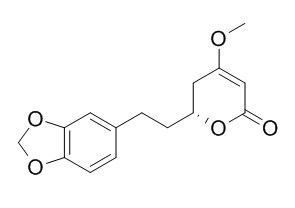Dihydromethysticin
Dihydromethysticin non-competitively inhibits the specific binding of [3H]-batrachotoxinin-A 20-alpha-benzoate to receptor site 2 of voltage-gated Na+ channels.The induction of CYP3A23 by dihydromethysticin and desmethoxyyangonin involves transcription activation, probably through a pregnane X receptor (PXR).-independent or PXR-involved indirect mechanism.
Inquire / Order:
manager@chemfaces.com
Technical Inquiries:
service@chemfaces.com
Tel:
+86-27-84237783
Fax:
+86-27-84254680
Address:
1 Building, No. 83, CheCheng Rd., Wuhan Economic and Technological Development Zone, Wuhan, Hubei 430056, PRC
Providing storage is as stated on the product vial and the vial is kept tightly sealed, the product can be stored for up to
24 months(2-8C).
Wherever possible, you should prepare and use solutions on the same day. However, if you need to make up stock solutions in advance, we recommend that you store the solution as aliquots in tightly sealed vials at -20C. Generally, these will be useable for up to two weeks. Before use, and prior to opening the vial we recommend that you allow your product to equilibrate to room temperature for at least 1 hour.
Need more advice on solubility, usage and handling? Please email to: service@chemfaces.com
The packaging of the product may have turned upside down during transportation, resulting in the natural compounds adhering to the neck or cap of the vial. take the vial out of its packaging and gently shake to let the compounds fall to the bottom of the vial. for liquid products, centrifuge at 200-500 RPM to gather the liquid at the bottom of the vial. try to avoid loss or contamination during handling.
Antioxidants (Basel).2020, 9(11):1121.
Heinrich Heine University Dusseldorf2021, 62203.
South African Journal of Botany2024, 168:209-220.
Indian J. of Experimental Bio.2020, 9(58).
LWT2020, 124:109163
iScience.2020, 23(2):100849.
Molecules.2019, 24(10):E1926
Int J Mol Med.2019, 43(6):2516-2522
Int J Mol Sci.2024, 25(12):6456.
J Biochem Mol Toxicol.2020, 34(7):e22489.
Related and Featured Products
Drug Metab Dispos. 2004 Nov;32(11):1317-24.
Desmethoxyyangonin and dihydromethysticin are two major pharmacological kavalactones with marked activity on the induction of CYP3A23.[Pubmed:
15282211]
Kava kava (Piper methysticum), an herbal remedy, is widely used for the treatment of mild to moderate cases of anxiety. The therapeutic activity is presumably achieved through multiple constituents called kavalactones. Recently, kava extracts were shown to induce CYP3A4 and activate human pregnane X receptor (PXR).
METHODS AND RESULTS:
This study was undertaken to test the ability of purified kavalactones to induce CYP3A23 and activate PXR. Rat hepatocytes were treated with desmethoxyyangonin, dihydrokawain, Dihydromethysticin, kawain, methysticin, or yangonin, and the expression of CYP3A23 was monitored. Among the kavalactones, only desmethoxyyangonin and Dihydromethysticin markedly induced the expression of CYP3A23 (approximately 7-fold). A similar magnitude of induction was detected with combined six kavalactones at a noninductive concentration when individually used. The induced expression, however, was markedly reduced or completely abolished if Dihydromethysticin, desmethoxyyangonin, or both were excluded from the mixtures. Interestingly, regardless of whether Dihydromethysticin or desmethoxyyangonin was used alone or together with other kavalactones, similar amounts of total kavalactones were needed to produce comparable induction, suggesting that the inductive activity of Dihydromethysticin and desmethoxyyangonin is additively/synergistically enhanced by other kavalactones. In addition, treatment with Dihydromethysticin, desmethoxyyangonin, or pregnenolone 16alpha-carbonitrile (PCN) markedly increased the levels of CYP3A23 mRNA, and inhibition of mRNA synthesis abolished the induction. In contrast to PCN, Dihydromethysticin and desmethoxyyangonin only slightly activated rat or human PXR.
CONCLUSIONS:
These findings suggest that the induction of CYP3A23 by Dihydromethysticin and desmethoxyyangonin involves transcription activation, probably through a PXR-independent or PXR-involved indirect mechanism.
Planta Med. 1998 Jun;64(5):458-9.
Kavain, dihydrokavain, and dihydromethysticin non-competitively inhibit the specific binding of [3H]-batrachotoxinin-A 20-alpha-benzoate to receptor site 2 of voltage-gated Na+ channels.[Pubmed:
9690349 ]
METHODS AND RESULTS:
The mode of action of the kava pyrones, kavain, dihydrokavain and Dihydromethysticin on the specific binding of [3H]-batrachotoxinin-A 20-alpha-benzoate to epitope 2 of voltage-dependent Na+ channels was investigated by performing saturation experiments in the presence and absence of these kava pyrones. The tested compounds significantly decreased the apparent total number of binding sites (Bmax) for [3H]-batrachotoxinin-A 20-alpha-benzoate (control: 0.5 pmol/mg protein, kava pyrones: 0.2-0.27 pmol/mg protein) with little change in the equilibrium constants (KD) for [3H]-batrachotoxin-A 20-alpha-benzoate (control: 28.2 nM, kava pyrones: 24-31 nM).
CONCLUSIONS:
The results indicate for the kava pyrones a non-competitive inhibition of the specific [3H]-batrachotoxinin-A 20-alpha-benzoate binding to receptor site 2 of voltage-gated Na+ channels.



